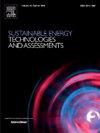Development of a framework for decarbonising the electricity supply under climate change scenarios
IF 7.1
2区 工程技术
Q1 ENERGY & FUELS
Sustainable Energy Technologies and Assessments
Pub Date : 2025-04-01
DOI:10.1016/j.seta.2025.104295
引用次数: 0
Abstract
When developing a decarbonisation scenario for future electricity supply, a holistic approach to the electricity generation mix should be taken while considering the climate-induced changes to resource availability and variability. The objective of this study was to develop a framework for a resource-based analysis of the optimal renewable mix to decarbonise future electricity supplies. The Weather Research and Forecasting model (WRF) was used to run very high resolution (≈1 km2) simulations using the latest climate change scenarios (CMIP6 SSPs), to then calculate the wind power density, solar photovoltaic power density and future changes to water availability. A fully decarbonised electricity supply scenario was proposed based on a site selection algorithm that selects the most cost-effective source between wind and solar combined with changes to hydroelectricity. The results show that most of the study area is viable for solar photovoltaic while floating wind is the most cost-effective solution. Overall, wind power has the highest potential contribution to total electricity production, with 54 % for SSP2-4.5 and 46 % for SSP5-8.5. Additionally, the results suggest that the amount of land required for the implementation of renewable installations to meet future demand is equivalent to less than 2 % of the study domain area.
制定气候变化情景下电力供应脱碳框架
在为未来的电力供应制定脱碳方案时,应考虑气候引起的资源可用性和可变性变化,对发电组合采取整体方法。这项研究的目的是为基于资源的最佳可再生能源组合分析开发一个框架,以使未来的电力供应脱碳。气象研究与预报模式(WRF)采用最新气候变化情景(CMIP6 ssp)运行非常高分辨率(≈1 km2)的模拟,计算风电功率密度、太阳能光伏功率密度和未来水可用性变化。提出了一个完全脱碳的电力供应方案,该方案基于选址算法,在风能和太阳能之间选择最具成本效益的能源,并结合水电的变化。结果表明,大部分研究区域适合太阳能光伏发电,而浮动风是最具成本效益的解决方案。总体而言,风电对总电力生产的潜在贡献最大,SSP2-4.5为54%,SSP5-8.5为46%。此外,结果表明,实施可再生能源设施以满足未来需求所需的土地数量相当于研究领域面积的不到2%。
本文章由计算机程序翻译,如有差异,请以英文原文为准。
求助全文
约1分钟内获得全文
求助全文
来源期刊

Sustainable Energy Technologies and Assessments
Energy-Renewable Energy, Sustainability and the Environment
CiteScore
12.70
自引率
12.50%
发文量
1091
期刊介绍:
Encouraging a transition to a sustainable energy future is imperative for our world. Technologies that enable this shift in various sectors like transportation, heating, and power systems are of utmost importance. Sustainable Energy Technologies and Assessments welcomes papers focusing on a range of aspects and levels of technological advancements in energy generation and utilization. The aim is to reduce the negative environmental impact associated with energy production and consumption, spanning from laboratory experiments to real-world applications in the commercial sector.
 求助内容:
求助内容: 应助结果提醒方式:
应助结果提醒方式:


